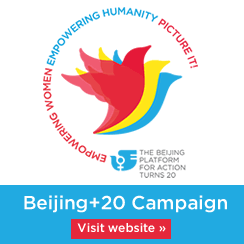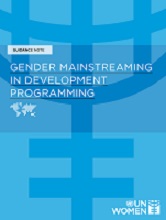Gender Mainstreaming
The gender equality and women’s empowerment mandate is universally agreed on by Member States and encompasses all areas of peace, development and human rights. The mandates on gender equality derive from the United Nations Charter, which unequivocally reaffirmed the equal rights of men and women.
The 1995 Fourth World Conference on Women endorsed gender mainstreaming as a critical and strategic approach for achieving gender equality commitments. The resulting Beijing Declaration and Platform for Action mandates all stakeholders in development policies and programmes, including UN organizations, Member States and civil society actors, to take action in this regard. Additional commitments are embodied in the outcome of the twenty-third special session of the General Assembly, the Millennium Declaration, and a variety of resolutions and decisions of the UN General Assembly, the Security Council, the Economic and Social Council, and the Commission on the Status of Women.
The 1997 agreed conclusions of ECOSOC defined gender mainstreaming as: “The process of assessing the implications for women and men of any planned action, including legislation, policies or programmes, in all areas and at all levels. It is a strategy for making women’s as well as men’s concerns and experiences an integral dimension of the design, implementation, monitoring and evaluation of policies and programmes in all political, economic and societal spheres so that women and men benefit equally and inequality is not perpetuated. The ultimate goal is to achieve gender equality.”
As such, gender equality is the overarching and long-term development goal, while gender mainstreaming is a set of specific, strategic approaches as well as technical and institutional processes adopted to achieve that goal. Gender mainstreaming integrates gender equality in national public and private organizations, in central or local policies, and in services and sectoral programmes. In the long run, it aims to transform discriminatory social institutions, laws, cultural norms and community practices, such as those limiting women’s access to property rights or restricting their access to public space
Key tools and resources
- Gender mainstreaming: A global strategy for achieving gender equality and the empowerment of women and girls
- Repository on gender mainstreaming policies in the United Nations system
- Repository on resources and tools for capacity development on gender mainstreaming within the United Nations system
- A list of official documentation on UN system-wide policy and strategy, with links to resolutions and reports on gender mainstreaming by ECOSOC and the General Assembly, as well as the policy of the United Nations Chief Executives Board for Coordination.
Latest news
Featured Publication
-
Gender Mainstreaming in Development Programming
This publication displays how the 1995 Beijing Platform for Action commits all stakeholders in development policies and programmes to take action. More

